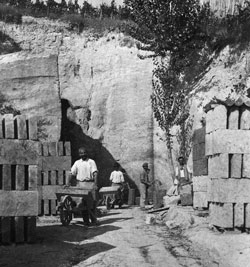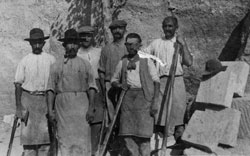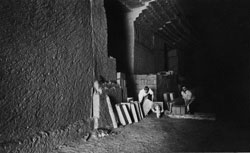|
Quarrymen and Mines of the Colma |
The mining of cornerstones
from the mines
(by Anita Rosso)
The hill of the Colma has in its subsoil the cornerstone
("Pietra da Cantoni"),
better (and improperly) known as "tuff": it is a fine grain, tender and friable
calcareus
marl and marly sandstone.
These marine rocks deposited, 18-12 millions years
ago, at a relatively shallow sea depths. This sea occupied
most of the Monferrato area; as
a matter of fact, it is not difficult to find fossil shells or
fish teeth in the blocks, used during
the building up of the houses.
Many mines were opened;
inside there the layer of "tuff"
had a thickness of about 10 m and followed the outline
of the hill; for centuries these mines supplied with
building
materials. The mines were formed by tunnels 5 m width
, with a height of 5 m too. From the main gallery departed,
perpendicularly, entry tunnels and other galleries which
were parallel to the main one.
The galleries bays were 5 m width and between a digging
out and the other there was another space left 5 m
width too. The main purpose of this solution was for safety
reasons: to avoid the collapsing of the gallery. Many digging
outs, further to the extraction of the tuff, were filled
in with recovery materials deriving from the squaring of
the blocks.
|

wheel
barrows out of a quarry
|
The dimensions of the blocks of squared "tuff", in vernacular
named “canton”, were 50 cm x 25 cm x 15
cm, with
a total weight of around 32 Kg.
They were used for the building
up of houses and rural residences. The dimensions of the
flat tiles (in vernacular, “pianeli”) were different, larger and higher but much thinner, with a weight of around
45Kg, used for the building up of ovens. |
|
Some mines are
still visible, though by now neglected more than a half
of a century ago.
Many were the professional quarrymen who worked in the
digging out of the blocks of squared tuff, but many others
were also the so called “seasonal workers” who
worked in mines to provide for the needs of their families.
These latest, in addition to the hard farm work they carried
out this activity and, once mined and piled up, the
"canton"
were carried away with burrows dragged by horses.
More or less important mines were managed by the
Angelino,
Campagnola
and Valleggia families.
|

quarrymen

the inner
part of a quarry
|
|